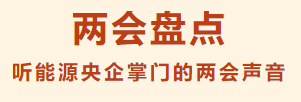The Two Sessions| Advice and Suggestions from Heads of Central Energy Enterprises
- Ma Yongsheng, member of National Committee of the CPPCC, Party Secretary and Chairman of Sinopec Corp., suggested to restart the China Certified Emission Reduction Scheme (CCER) market, designing and releasing methodologies of Carbon Capture, Utilization and Storage (CCUS), and accelerate the inclusion of CCUS project into CCER to better achieve the “double carbon” goal.
- Wang Dongjin, member of the National Committee of the CPPCC, Party Secretary and Chairman of CNOOC Group, put forward four policy suggestions for the development of sub-seabed carbon dioxide storage:
- First, use sub-seabed carbon dioxide storage as an important strategic measure to achieve carbon neutrality, and to systematically carry out top-level design of engineering demonstration and industrial development. Study and establish a major special project for sub-seabed carbon dioxide storage technology to provide technical support for industrial development; select areas with good source-sink matching to carry out full-process engineering demonstrations of more than one million tons; rely on engineering demonstrations to establish and improve systems related to the mineral rights of stored carbon, project regulation, carbon emission reduction certification and carbon market offsets.
- Second, introduce targeted incentive policies based on different stages of sub-seabed carbon dioxide storage. Keep technological research and engineering demonstrations as the main goal before 2030, increase financial support for scientific research, set up major special projects for technological research and development and result incubation; support enterprises to carry out engineering demonstrations, study and establish a package of policies such as project fund subsidies, green finance, tax incentives and carbon market linkage to promote healthy development of the industry.
- Third, fully consider the synergy between offshore oil and gas development and the industrial development of sub-seabed carbon dioxide storage, give full play to oil and gas companies to show their professional advantages in geological structure, engineering construction, drilling and completion, etc., and reduce costs by recycling abandoned oil and gas reservoirs and equipment facilities in offshore oil and gas development, thus creating a long-term unit in the industrial chain.
- Fourth, launch the sub-seabed carbon dioxide storage demonstration project as a key project to implement the China-US Sunnylands Statement, and promote the implementation of megaton-scale and above sub-seabed carbon dioxide storage demonstration projects across the whole industrial chain in sea areas with high suitability for sub-seabed storage such as the Bohai Bay, the Pearl River Estuary, and the Yangtze River Delta region. These demonstration projects can provide useful reference for the industrial development of CCUS in China.
- Wen Shugang, member of the National Committee of the CPPCC, Party Secretary and Chairman of China Huaneng Group Co., Ltd., said that in the ten years of the new era, China’s energy and power industry has made great achievements in green and low-carbon development, while changes are happening in mode of electric power system thanks to the large-scale and high-proportion development of new energy. How to solve the “triangular problem” of safety, cleanliness and economy is a major issue faced by the global energy and power fields.
- Wen Shugang suggested that new energy distribution and storage should be tailored to local conditions with full considerations to the characteristics of the power supply, and optimize the scale and type of new energy distribution and storage. Encourage to build new energy bases to allocate energy storage in a centralized manner, support the construction of an energy storage capacity leasing market, and actively develop shared energy storage, grid-side energy storage, and user-side energy storage. Accelerate the establishment of a “new energy + energy storage” integrated dispatching mechanism, give full play to the multiple roles of energy storage, such as peak and frequency regulation and power support, to further improve utilization levels. Clarify the positioning of the energy storage market, accelerate the construction of the electricity market, ancillary service market and spot market, showing the diverse value of energy storage.
Source: Energy Research Institute



